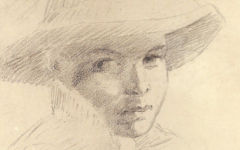Courbet’s Alfred Bruyas (1853)

Courbet, Bonjour, Monsieur Courbet (1854) Oil on canvas. Musée Fabre, Montpellier
Click image to enlarge.
Alfred Bruyas, the man at left with the red beard facing Courbet, was a wealthy art lover and art critic. As Courbet's first and most loyal patron, his opinions on art are often used by other writers as though they could illuminate Courbet's. Like much art criticism, though, his thoughts are often obscure and are replete with jargon. Solution and truth in painting, the former even used in the title to the next image, are two such examples which may mean something in terms of style but nothing in terms of meaning.
Click next thumbnail to continue

Left: Courbet, Alfred Bruyas (Painting-Solution) (1853) Oil on canvas. Musée Fabre, Montpellier
Right: Titian, Self-portrait (c.1550)
Click image to enlarge.
The portrait of Bruyas at far left uses no face fusion while still representing an aspect of Courbet's mind. His finger curls towards himself as if to say "I paint myself" while the other is pressed onto a nearby table. It is reminiscent of Titian's hand about to "paint" a similarly empty table in his best-known self-portrait (near left). Moreover, the watch chain hanging from Bruyas' waistcoat pocket is a modern version of the gold chains artists like Titian received and proudly wore in their self-portraits, as here as well.
Click next thumbnail to continue

Detail of watch chain in Courbet's Alfred Bruyas (Painting-Solution) with inset of Courbet's signature from the same painting
Click image to enlarge.
The watch chain is not only painted in the same color as Courbet's signature (see inset for detail) but its first links resemble the loops of the initial G at the start to Courbet's signature. Bruyas' watch chain has been turned into a hidden and modern attribute of Courbet as a great master.
Click next thumbnail to continue

Left: Detail of Bruyas from Courbet's The Painter's Studio (1855)
Right: Courbet, Self-portrait with Striped Collar (1854) Oil on canvas. Musée Fabre, Montpellier
Click image to enlarge.
When Courbet came to include Bruyas in his first great masterpiece, The Painter's Studio, a recognized summation of Courbet's artistic life to date (see detail at far left), he dressed his patron with a striped collar remarkably similar to that he himself wears in the same painting and in a separate study for the self-portrait (near left).
See conclusion below
Courbet wanted to be seen as a revolutionary overthrowing tradition because that is what the market, the art world and public expect. It guaranteed fame. The public for art, though, concentrated not on the meaning of his art as poetry but on its similarity to life, its style. That is why he is called a Realist. Yet as Linda Nochlin has shown over many years the actual "realism" of Courbet's art was less about his art's faithfulness to perceived reality than to an inner contemplation which gives unity to his oeuvre.1 She is right, even if unaware of its content. Like many great masters before him, Courbet painted in a modern style while maintaining art's inner tradition, a meaning hidden in allegory. That is why Nochlin sensed its unity. Art's tradition, the self-reflective poetry behind the images, is a fundamental truth that no great master can deny and still take his or her place in the canon.
More Works by Courbet
This painting like many of Courbet's images of caves and the sources of rivers consists of a dark hole with rock swirling around it in the form of an eye.

Courbet’s Grotte de la Source Enneige (c.1866)
Notes:
1. Dominique de Font-Réaulx, "Realism and Ambiguity in the Paintings of Gustave Courbet" in Gustave Courbet (New York: Metropolitan Museum) 2008, pp. 39-40
Original Publication Date on EPPH: 27 Dec 2011. | Updated: 0. © Simon Abrahams. Articles on this site are the copyright of Simon Abrahams. To use copyrighted material in print or other media for purposes beyond 'fair use', you must obtain permission from the copyright owner. Websites may link to this page without permission (please do) but may not reproduce the material on their own site without crediting Simon Abrahams and EPPH.


